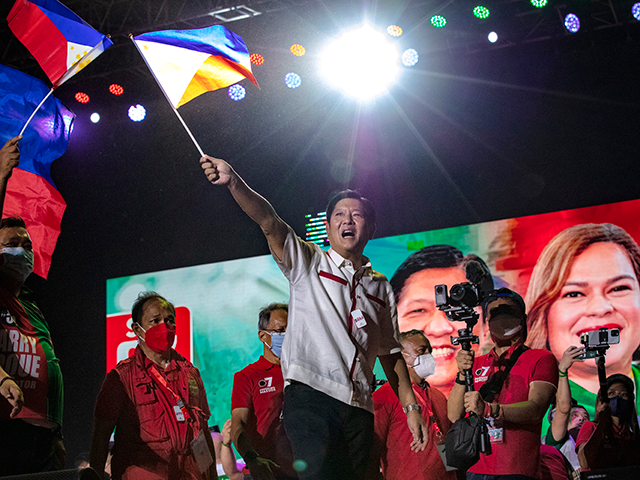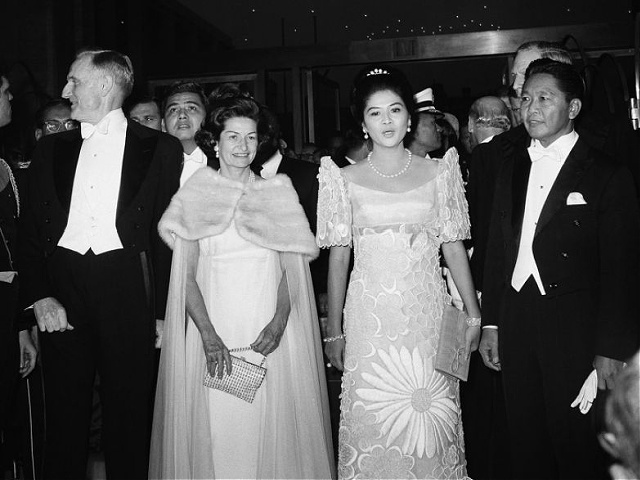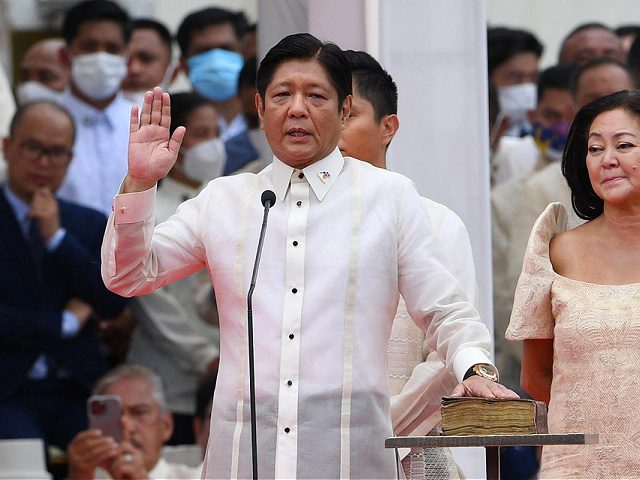Ferdinand Marcos Jr. became the Philippines’ 17th president last week after over four decades in politics that began under the shadow of his father, former Philippine leader Ferdinand Marcos Sr.
Marcos Jr. — known by his nickname “Bongbong” or as simply “BBM” — is the only son of Marcos Sr., who ruled the Philippines as president and prime minister from 1965 to 1986. Marcos Sr. imposed martial law on the Philippines for roughly half of his tenure (1972-1980), running what has widely been derided as a dictatorship. While he held elections before he assumed either the president’s or prime minister’s office, they were timed irregularly and attracted accusations of fraud.
Filipinos elected Marcos Sr. as their tenth president in 1965 and reelected him to the office in 1969. Starting in 1971, however, he “played up middle-class fears” amid a “swell of student radicalization and [an] increasing number of violent [anti-capitalist] demonstrations, and used these to justify the imposition of Martial Law on September 23, 1972,” according to the Philippine government’s Official Gazette.
“Martial Law was not just an invocation of the President [Marcos]’s emergency powers under the 1935 Constitution—Marcos went further to assume all governing powers, excluded civilian courts, and systematically replaced the 1935 Constitution with the 1973 Constitution for his own ends,” according to the journal.
“Tens of thousands of people were imprisoned, tortured or killed for perceived or real criticism of the government, human rights groups say,” left-wing outlet CNN recalled in May of Marcos Sr.’s rule from about 1972 on. “As well as its restrictions on citizen rights and a brutal military police, the Marcos regime was marked by widespread corruption, with an estimated $10 billion stolen from the Filipino people.”
The U.S.-backed Marcos Sr. was ousted from Malacañang in 1986 during a non-violent “People Power” revolution led mainly by Philippine civilians. The popular uprising forced Marcos Sr. and his family to flee, with Washington’s assistance, to the U.S. state of Hawaii in 1986. Marcos Sr. was succeeded as Philippine president by the widow of his political rival, Corazon Aquino, and died in Hawaii in 1989.
Marcos Jr. 64, served as vice-governor of Ilocos Norte, his father’s home province in the Philippines’ north, from 1980 to 1983 and then served as Governor of Ilocos Norte from 1983 to 1986.
“Marcos Jr. was 23 when he became vice governor of the northern province of Ilocos Norte in 1980, running unopposed with his father’s party [the right-wing New Society Movement (KBL)],” according to CNN.
The political scion returned to the Philippines from Hawaii in 1991 and almost immediately launched a successful campaign for Congressman of Ilocos Norte (2nd District) despite his father’s tainted legacy. Ilocos Norte may have been quick to embrace Marcos Jr. because his family had long-established ties to the region. Filipinos have historically elected several political dynasties on both a local and national scale. Philippine politicians often build strong support bases in their provinces of origin and then work to perpetuate regional dominance, which is what the Marcos family seems to have successfully done in Ilocos Norte.

Ferdinand “Bongbong” Marcos Jr. waves a Philippine flag during his last campaign rally before the election on May 07, 2022, in Paranaque, Metro Manila, Philippines. (Ezra Acayan/Getty Images)
Professors from the University of the Philippines-Diliman observed in 2013 “[a] general trend in Philippine politics whereby 70 percent of the 15th Philippine Congress is dynastic.”
Marcos Jr. served as Congressman of Ilocos Norte (2nd District) from 1992 to 1995 before his election to Ilocos Norte’s governorship in 1998. After serving as the province’s leader through 2007, Marcos Jr. chose to run again for Congressman of Ilocos Norte (2nd District). He served in the role from 2007 to 2010 before embarking on his first foray into national politics. Marcos Jr. was elected a Philippine senator in 2010 and served in the post through 2016.
Marcos has enjoyed tremendous success as a politician without creating a clearly defined ideological persona, instead running under populist banners and making center-left proposals like increasing budget spending and softening the nation’s war o communist terrorists — ideas also shared with his predecessor, Rodrigo Duterte.
Marcos Jr. was a member of the Philippines’ populist Nacionalista political party from 2009 to 2021. Before that, he represented the populist Kilusang Bagong Lipunan party (an offshoot of the Nacionalista party) from 1980 to 2009.
Marcos Jr. suggested in June that he plans to continue Duterte’s “War on Drugs” in the Philippines, which saw his administration crackdown on illicit drug offenders with a heavy hand. In May, Marcos Jr. announced his then-incoming administration’s budget for 2023, which was a record-high “P5.268 trillion,” or roughly USD $94.3 billion.
“The proposed budget next year is equivalent to 22.1% of the country’s gross domestic product,” the Philippines’ GMA news outlet reported.
“The budget ceiling approved by the economic managers is higher than the P5.242-trillion pegged by the economic team in December 2021,” GMA observed.
Marcos Jr.’s administration in mid-June suggested it would work toward less stringent labeling of the nation’s communist terrorists, according to a report by Voice of America (VOA), allegedly to avoid demonizing political opponents or human rights activists.
The Philippine government, under the new administration of Marcos Jr., officially designated “five suspected Muslim militants and six suspected members of the outlawed communist party as ‘terrorists,’ [in mid-June] saying the move will allow authorities to freeze financial assets that could be used for funding attacks,” the U.S. government-funded BenarNews broadcaster reported.
Marcos Jr.’s official website states the following about his political policies:
When he was a Governor, BBM transformed Ilocos Norte into a first-class province. […] Despite its dry landscape, BBM modernized both the agricultural and tourism landscape in Ilocos Norte. Under his watch, the province became both an agricultural exporter and tourism hotspot.
The website further noted that Marcos Jr. is “an advocate of renewable energy for sustainable development” and that he “built wind farms in various areas of the province [Ilocos Norte] to sustain not only the energy supply of Ilocos Norte but also for the rest of Luzon.”

First Lady Lady Bird Johnson, second from left, Pres. Lyndon Johnson, left, and Mrs. Imelda Marcos, wife of the President of the Philippines, Ferdinand Marcos, right, arrive at Lincoln Center for the opening performance at the Metropolitan Opera House, Sept. 16, 1966, New York. (AP Photo)
Marcos Jr. expressed the following on May 26 about China’s increasing encroachment on Philippine territory in the South China Sea:
There is no wiggle room there. Our sovereignty is sacred. We will not compromise it in any way. We are a sovereign nation with a functioning government. We do not need to be told by anyone how to run our own country. There is no room for negotiation there. It is sacred, inviolable.
Marcos first ran as a political independent for the 2016 Philippine vice-presidential election (the nation elects presidents and vice presidents separately). Marcos’s campaign was ultimately unsuccessful as he came in second place to Leni Robredo. He lost by a historically narrow margin and contested the poll’s results to no avail.
Duterte, whom “Bongbong” succeeded in the presidency last week, met with Marcos Jr. in September 2015, allegedly to discuss running together for president and vice president, respectively, in the 2016 Philippine general election, CNN Philippines reported at the time. Though this theoretical tandem did not come to fruition, it suggests that the two leaders may have shared a political vision.
Marcos reportedly vowed to avenge his 2016 loss by running against Robredo again for the 2022 Philippine presidential election. He beat out both Robredo and boxer-turned-Philippine Sen. Manny Pacquiao to win the office of the Philippine presidency on May 11.
“Marcos, 64, has presented no real policy platform, campaigning on a simple but ambiguous message of unity,” Reuters observed of the politician on May 10.
Rodrigo Duterte was ineligible to run for president again in 2022 as Philippine law limits presidents to a single, six-year term.
Marcos Jr. successfully ran for the 2022 Philippine presidential election as chairman of the Partido Federal ng Pilipinas (PFP), which is a federalism-based political party established by his predecessor, Duterte. Marcos Jr. joined forces with Rodrigo Duterte’s daughter, former Davao City Mayor Sara Duterte, to run for president and vice president, respectively, in this year’s Philippine general election. Sara Duterte was elected vice president of the Philippines on May 9 and sworn in on June 19.

COMMENTS
Please let us know if you're having issues with commenting.